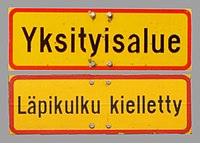Key:pihatie
 |
| Description |
|---|
| A way on apartment building courtyard with "No trespassing" or "Private property" signs in areas with freedom to roam laws that are (probably) overruling them. |
| Group: restrictions |
| Used on these elements |
| Useful combination |
|
|
| Status: in use |
| Tools for this tag |
|
A Finnish peculiarity: tags a driveway or a footway on an apartment building courtyard ("pihatie" in Finnish) that has "No trespassing" ("Ei läpikulkua"/"Läpikulku kielletty" in Finnish), "Private property" ("Yksityisalue" in Finnish) or similar (see the example pictures) signs next to it.
Based among other things on discussion on the Finnish section of OSM Forum[1] and a pamphlet published by the Ministry of the Environment "Everyman’s rights and the code of conduct on private land. SY 5en 2015." (PDF)[2].
Rationale
Finnish (and more generally Nordic) Freedom to roam laws grant almost universal access to walk on all roads and paths.
One notable exception to these freedoms are the driveways or paths on the yards of homes and semi-detached or terraced houses, even when these driveways or paths route between roads. They are "considered a part of the domestic premises" and not legally generally accessible (op.cit., p. 119). Thus, when applicable, these paths can be tagged with an appropriate, restrictive access=* tag (usually access=private or access=destination).
On the other hand, roads on the yards of apartment buildings are explicitly not excepted and are therefore free to use for everyone under the Freedom to Roam laws. Thus the "No trespassing"/"Private property" signs do not carry the force of law on apartment building yards in Finland, despite their ubiquity in Finnish cities:
- The sign Private area is often used to mark a yard. However, the sign Private area does not directly prohibit the use of the area under everyman’s rights [...]. Setting a Private area sign is usually allowed, because it does not prohibit movement, rather it only expresses the owner’s opinion of the borders of the private area. op. cit. p. 118
- Erecting a No Trespassing sign is allowed, if it indicates the border of a yard of domestic premises, for example. The common yard of an apartment building is not part of domestic premises, but based on its right of possession, a housing company can set up signs directing traffic to protect the lawn or for similar purposes. op. cit. p 119
Consequently these paths should not be tagged with a restrictive access tag.
The pihatie=* tag is therefore used in stead to communicate the housing co-operative's (not legally binding) wish that their yard not be used for general transit.
This tag is warranted for possible routing purposes and because of the ubiquity of the signs in Finland. Most housing co-operatives still tacitly expect the restrictions expressed in the signs to be obeyed (as exemplified by the third example picture and its footnote), even though they only express the owner's opinion and do not in fact prohibit movement on apartment building yards.
Notice also that:
- A user of everyman’s rights must not remove any signs he or she observes, even if they are illegal, because they fall under the protection of property. Problematic signs can be reported to the police, or to any authority that may be mentioned on the sign. op. cit. p. 119
The signs also have a somewhat unclear legal status: an established legal praxis concerning them does not exist and there is disagreement within the legal community as to the exact status of the signs and restrictions they express, as documented in the Forum discussion (in Finnish).
Usage
A way on the courtyard of an apartment building (usually highway=pedestrian, highway=service, highway=footway or highway=path, possibly with area=yes) that also has either "No trespassing" ("Ei läpikulkua" in Finnish) or "Private property" ("Yksityisalue" in Finnish), or similar (see the example pictures) signs posted next to it.
The exact locations of the boundaries of properties are available at least for Helsinki in the Ajantasa-asemakaava data, which is available as a WMS-layer readily useable in e.g. JOSM. Usually the boundaries of yards of apartment buildings can be ascertained and inferred in situ from the presence of e.g. a fence or a barrier-hedge.
Values
| Tag | Usage |
|---|---|
pihatie=yes
|
Generic tag: An applicable way with both or similar (see the example pictures) signs present. |
pihatie=yksityisalue
|
An applicable way with a "Private property" ("Yksityisalue" in Finnish) sign. |
pihatie=läpikulku_kielletty
|
An applicable way with a "No trespassing" ("Ei läpikulkua"/"Läpikulku kielletty" in Finnish) sign. |
Examples
Examples of unequivocal signs. |
 |
 |
References
- ↑ https://forum.openstreetmap.org/viewtopic.php?id=69852
- ↑ https://helda.helsinki.fi/bitstream/handle/10138/159060/SY_5en_2015.pdf
- ↑ This sign demonstrates a confusion with these signs and the prohibitions they express. The sign begs would-be trespassers to respect the inhabitants kotirauha (literally: domestic peace), even though the common yard of an apartment building is explicitly not covered by the Finnish legal concept of Kotirauha (domestic premises), as mentioned above.


